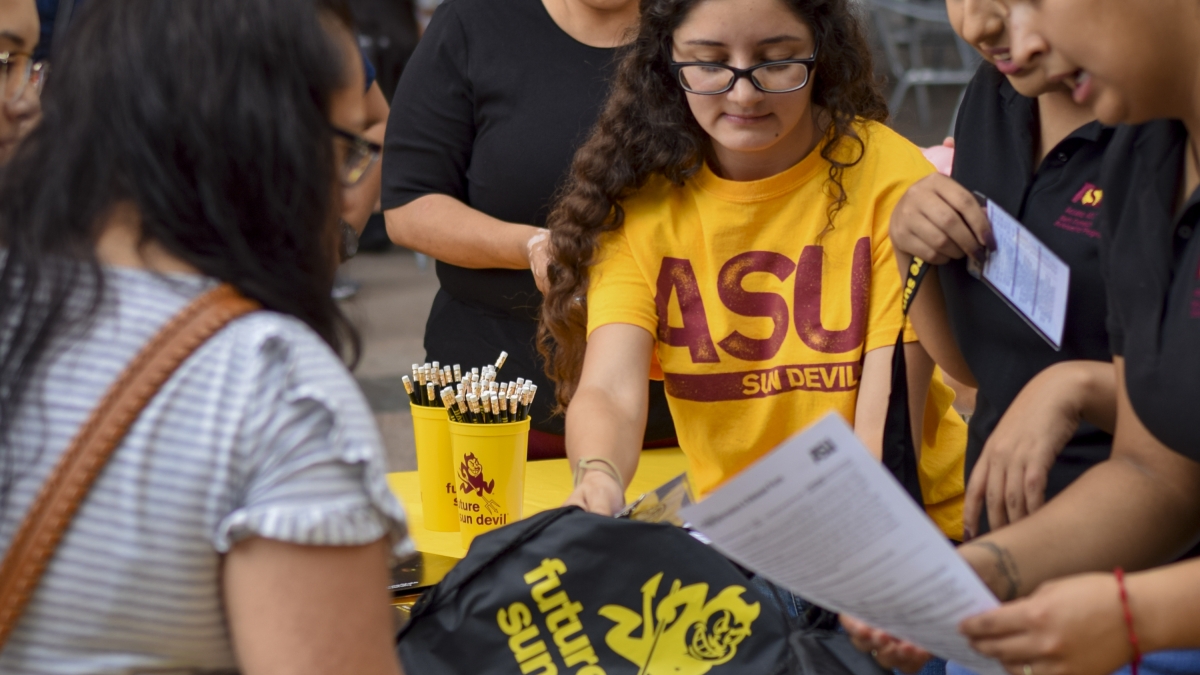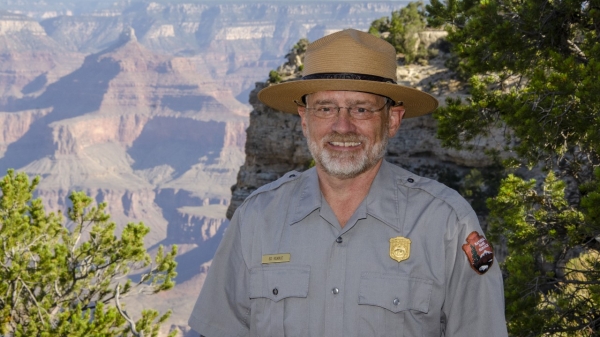Why demystifying FAFSA is key to boosting Arizona’s economy

Community members in Tempe received FAFSA resources at a recent Future Sun Devil Family Day event at the ASU Tempe campus.
At one point, when Arizona State University junior Jacqueline White was attending Mesa Community College, she was working three jobs to pay for school out of pocket. After she transferred to ASU, she realized she could have avoided that financial stress if only she had filled out a federal form she hadn’t ever heard of: FAFSA (Free Application for Federal Student Aid).
“It was only later on when I started attending ASU that I realized what FAFSA was. Come to find out, actually all my school would have been covered by a Pell Grant had I submitted [a] FAFSA.”
White, originally from Sierra Vista, Arizona, said being a first-generation student has meant learning these kinds of lessons along the way. Her parents didn’t have personal experience with higher education, and White said her high school didn’t have the resources to provide the guidance that she and her older sister needed as they began navigating the college admissions process.
“It’s been a learning curve, to be honest. … I never understood FAFSA or Pell Grants, and loans seemed very intimidating and scary,” White said.
Luckily, White earned scholarships that helped along the way and also learned about what FAFSA could do when she transferred to ASU. Now White is studying public policy and public service and has earned distinctions such as the Newman Civic Fellowship and the Boren Scholarship in her time as a Sun Devil.
Removing financial barriers for students like White is the goal of the community partners working on the Arizona FAFSA Challenge, which has a goal of increasing FAFSA completion in Arizona to 53% of high school seniors during the 2019–20 cycle.
Completing the FAFSA gives students access to grants, work-study opportunities, institution-based aid and federal student loans to pay for college — especially for students with high financial need. FAFSA applications for the 2020–21 school year open Oct. 1.
Rich Nickel, the president and CEO of College Success Arizona, describes FAFSA as a “silver bullet” when it comes to the affordability questions so many students face when considering pursuing a degree. And taking an hour to fill out the form can really pay off financially for families but also economically for the state.
“What we know is that there is massive upside tied to the completion of that form,” Nickel said. “The average awardee of FAFSA is provided just south of $10,000.”
The FAFSA goals that ASU and community partners are working toward accomplishing are part of the larger context of the Achieve60AZ goal: By 2030, 60% of adults in Arizona ages 25-64 will hold a degree or high-value credential. That would mean about a 15 percentage point increase over the next 11 years.
FAFSA completion is a crucial indicator of whether a high school senior is likely to enroll in college: 90% of high school seniors who complete the form attend college directly from high school. And in Arizona, one of the only states in the country without a robust, need-based financial aid system supported by state government, students depend even more on federal aid and therefore FAFSA completion.
Arizona currently ranks 49th in the country for FAFSA completion, partially because there are misconceptions about the process and partially because of a lack of resources to deliver consistent and quality information available about the process, especially in rural areas of Arizona.
Nickel said the low completion rate in the state is due to barriers such as an extremely low counselor-to-student ratio in Arizona of 950 students per counselor and also confusion among families about what’s required and where to find it. Parents and students might not know where to find tax information or might have fears about how their financial information will be used or kept private.
“FAFSA is a government form. Although it’s been wildly simplified over the last several years, it’s still intimidating to some people,” Nickel said.
Getting people quick access to FAFSA guidance is the inspiration behind Project Benjamin, a chatbot that will answer FAFSA questions 24/7 and provide nudges and support via text messages. ASU, as part of a coalition of cross sector community partners including Achieve60AZ, Arizona College Access Network, Arizona Postsecondary Commission, Be A Leader Foundation, College Success Arizona, Helios Education Foundation, Maricopa Community Colleges and Mesa Public Schools, was recently awarded $1 million in grant funding to launch the first FAFSA chatbot in the country. “Benji,” as the chatbot is known, will be utilized to serve 30,000 students and families throughout greater Maricopa County.
Technology tools help amplify the in-person work that’s already taking place via ASU’s early outreach programs and school- and district-level programming throughout Arizona. The community partnerships are also earning national attention: ASU was a partner in the Mesa Public Schools’ recent FAFSA completion award of $100,000 from the National College Access Network FAFSA Completion Challenge for a targeted effort to increase the FAFSA completion rate in Mesa schools by five percentage points in a year. Arizona State University worked with Mesa Public Schools on the development and submission of the FAFSA Challenge Grant proposal and provided training and staff to support FAFSA completion events across the district, which included data-informed community outreach and peer coaching for graduating seniors.
Michael Garcia, director of opportunity and achievement for Mesa Public Schools, said the 10% rise in FAFSA completion in Mesa has led to a steep rise in college applications and admissions.
“Students who gain access to financial aid are also more likely to have a secure financial future and will likely be stronger contributors to our local economy over a lifetime,” Garcia said. “It's a win for everyone. This is why this year we aim even higher than last year at 55% completion, compared with our goal of 45% last year.”
Overall, there’s a lot of momentum to move the needle on FAFSA completion. Nickel said even businesses are getting involved because of the economic benefits to the state and local communities. Since the average amount awarded for people who fill out FAFSA is nearly $10,000, middle-income families who participate see a huge economic effect, as does the local economy.
“You start adding that up, all of a sudden what you’re looking at for every percent we increase FAFSA completion literally can equate to millions of dollars of new federal money coming into our state, going to our institutions, paying salaries of people who work there, buying books, being used at local restaurants. The community is starting to see that,” Nickel said.
ASU leaders are dedicated to building on that momentum as a way to meet the goals of Achieve60AZ and continue to open up access to higher education for all Arizonans.
“Achieve60AZ is a launching pad for a lot of great work that is happening in Arizona, including FAFSA completion. We are proud to be partners in this work because the form is a crucial indicator for college going and also because it’s part of a blueprint for achieving educational outcomes that will advance our economy and improve people’s lives,” said Sylvia Symonds, associate vice president for ASU Educational Outreach and Student Services.
More Arts, humanities and education
AI literacy course prepares ASU students to set cultural norms for new technology
As the use of artificial intelligence spreads rapidly to every discipline at Arizona State University, it’s essential for…

Grand Canyon National Park superintendent visits ASU, shares about efforts to welcome Indigenous voices back into the park
There are 11 tribes who have historic connections to the land and resources in the Grand Canyon National Park. Sadly, when the…
ASU film professor part of 'Cyberpunk' exhibit at Academy Museum in LA
Arizona State University filmmaker Alex Rivera sees cyberpunk as a perfect vehicle to represent the Latino experience.Cyberpunk…